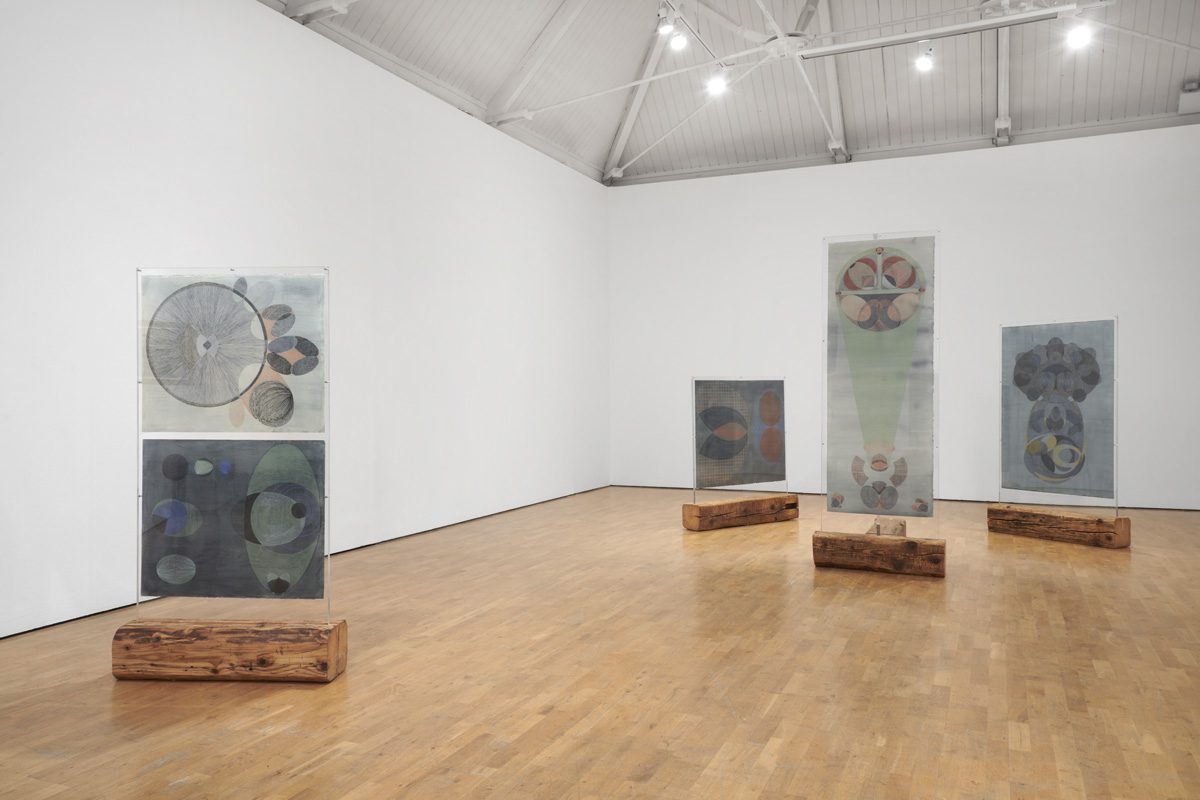“I don’t think of my drawings as going on the wall. It is a body you can walk around, not a flat thing. […] All my objects are installations in space.” – Johanna Unzueta
If you’ve been to see our current exhibition Johanna Unzueta: Tools for Life you will have noticed the unusual way Johanna’s drawings are displayed.

Rather than framed and hanging on the wall, they are freestanding, held between two sheets of plexiglass inserted into bases made of recycled wood. Some of the works are attached to the wall with hinges, and so stick outwards and can be looked at from both sides.

This is exactly how Johanna wants them to be seen and experienced. In fact, the framing materials – perspex and wood – are just as much a part of the works as the drawings themselves.
The style of display fits with Johanna’s vision of her works as installations, and with her respect for materials and production processes.
It is also a homage to Italian Brazilian modernist architect Lina Bo Bardi’s exhibition design for the Museu de Arte de São Paulo (MASP) in 1968.

Using concrete, glass and steel, Bo Bardi created a radical display system of 150 freestanding glass easels or panels, onto which the works in the museum are hung.
Each ‘easel’ in her display is made of a sheet of glass inserted into a cube of reinforced concrete. The traditional wall labels are attached to the back of the panels, so that they can be read through the glass behind.
This way, the viewer clearly sees the way in which the frames are constructed, and is encouraged to experience the works in three dimensions – considering the entire process of creation.

Walking amongst art works creates a kind of physical relationship between art works and viewers.
This is a way of avoiding the intimidating nature of traditional art displays. Adriano Pedrosa, the current artistic director at MASP writes:
“One of Bo Bardi’s intentions was to present artworks as products of labour, desacralising them and getting rid of the church-like, reverential atmosphere of the traditional museum.” (Mousse Magazine, December 2017-January 18)
We are used to seeing works of art hung on walls, out of reach. Like Bo Bardi, Johanna too wants us to have direct access to explore and share the space with tactile, material objects.

Bo Bardi herself was inspired by some of the 1940s exhibition displays she had seen in Italy. Franco Albini’s display at the Pinacoteca di Brera in 1941 featured works attached to thin pillars which stretched from floor to ceiling.

Albini in turn was reinterpreting a display at the Aeronautical Exhibition in Milan in 1934 by Edoardo Persico and Marcello Rizzoli, where boards of images and text were attached to a grid like structure.
Albini took this method of displaying information, and used it to display traditional works of art. His was a temporary exhibition display. Bo Bardi used this radical display technique and applied it to the permanent collection of a museum. Her display remained until 1996, when it was dismantled. It was reinstalled in 2015.

Johanna takes it another step further. Her works are designed as sculptures – as “installations in space” – and she gives the frames and stands as much value as the works themselves.
Johanna’s work celebrates all aspects of the processes of production. She gives value to all materials, all labour processes and all components of the whole, however humble.

One detail of Johanna’s works are the needle-holes pierced through some of the papers. She says of the first time she tried this technique that she held the paper to the window and watched the light shine through, and was amazed by the beauty of it. Her works are also designed to be looked through, and their framing allows for that.
Johanna pays homage to Bo Bardi’s desire to create an atmosphere, and to experiment with ways of showing. Johanna encourages her audience to play an active role in the viewing of the artworks. Viewers carve their own path around the drawings, and are exposed to all angles and aspects of these three-dimensional works.
Read more about Johanna Unzueta: Tools for Lifehere.
